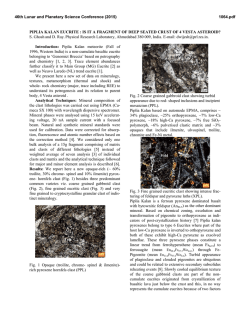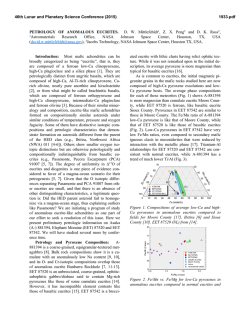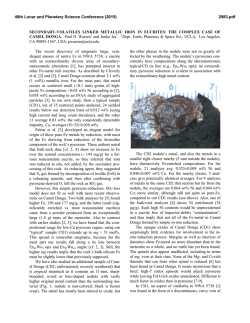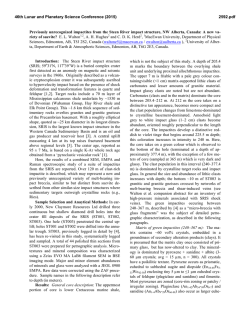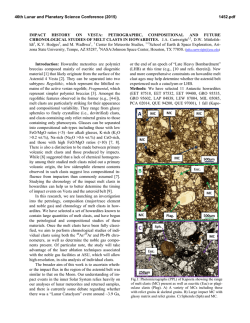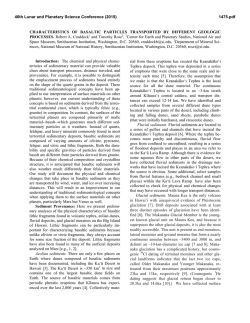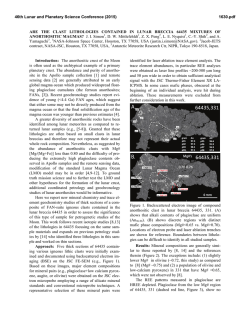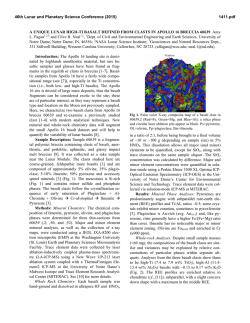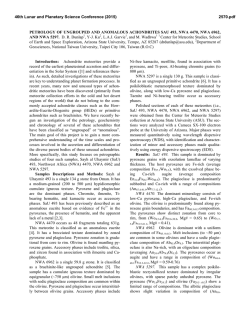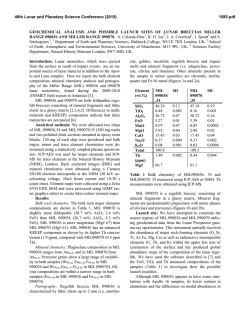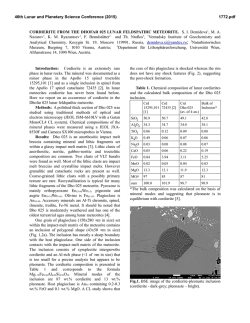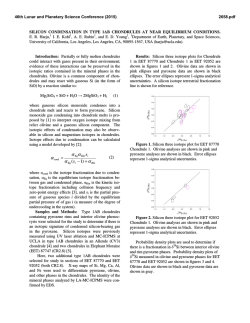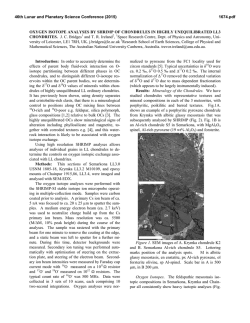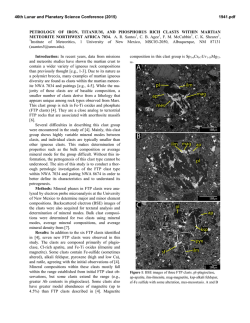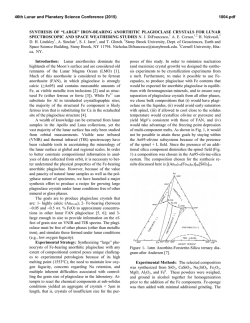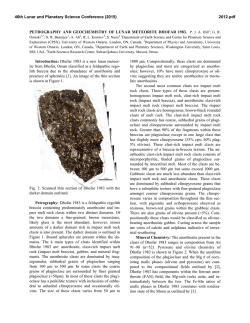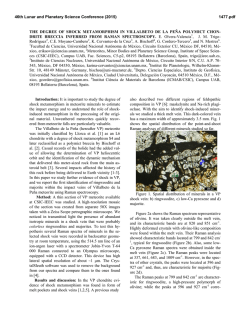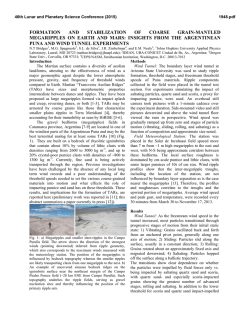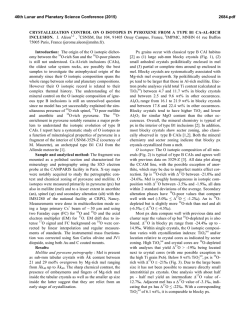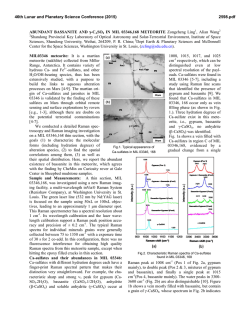
Characterisation of Howardite Regolith Breccia Miller Range 11100
46th Lunar and Planetary Science Conference (2015) 1996.pdf CHARACTERISATION OF HOWARDITE REGOLITH BRECCIA MILLER RANGE 11100. T. Gregory1 K. H. Joy1, and S. Strekopytov2, 1School of Earth, Atmospheric and Environmental Science, The University of Manchester, Manchester, M13 9PL, UK, 2Science Facilities Department, Imaging and Analysis Centre, The Natural History Museum, London, UK. (Email: [email protected]). Introduction: Howardites belong to the Howardite-Eucrite-Diogenite (HED) clan of meteorites, which likely originate on the asteroid (4) Vesta [1,2,3]. Howardites are polymict breccias, containing mostly eucritic and diogenitic clasts and mineral fragments [3]. These samples provide insights into both the magmatic evolution and impact history of their parent body. We present a study of Miller Range (MIL) 11100, a howardite regolith breccia collected in Antarctica in 2011 by ANSMET. Methods: Mineral chemistry of thin section MIL 11100,9 was investigated using a CAMECA SX100 Electron Probe Microanalyser electron microprobe at the University of Manchester. BSE images were collected using a Phillips XL30 FEG-SEM with an EDAX EDS system. Bulk chemistry of sample MIL 11100,7 (122.2 mg chip) was measured using ICP-MS and ICPAES at the NHM, London. Petrography: MIL 11100,9 contains angular to sub-angular clastic fragments ranging from large (maximum 2.3 mm in diameter) to very-fine grained (indistinguishable from the sub-µm matrix). This texture is typical of howardite regolith breccias [3]. Clasts are composed of eucritic and diogenitic mineral fragments and polymineralic lithic fragments, impact melt breccias and metamorphic granulite clasts. Eucritic pyroxene is the most common mineral fragment present in the sample and is commonly exsolved, with high and low Ca-pyroxene (Fig. 1). Figure 1. (a) MIL 11100,9 contains abundant exsolved pyroxene consistent with the composition of eucrites in [4]. Different coloured points represent individual mineral fragments. Diogenite field and eucrite fields adapted from [4]. MIL 11100 also contains more complex pyroxenebearing clasts, including lithic eucritic basaltic fragments, impact melt breccias, and metamorphosed granulite clasts (Fig. 2). The range in pyroxene compositions highlights the fact that both diogenitic and eucritic rocks are present in this sample, suggesting that both deeper crustal and shallower crustal areas were sampled. Figure 2. Pyroxene composition in lithic fragments, impact melts, diogenite fragments and metamorphic granulite clasts in MIL 11100. Diogenitic field and eucritic field adapted from [4]. Plagioclase is abundant in this sample, present as both matrix fragments and in more complex clasts (Fig. 3). Compositions range from An80 to An93. Figure 3. Plagioclase composition (An# = molar Ca/[Ca+Na+K] × 100) in matrix fragments and lithic polymineralic clasts in MIL 11100,9. Olivine is also present in the sample, primarily as grains in polymict clast-bearing impact melt breccias. These fragments are compositionally variable as two distinct groups; Fo14 and Fo42-43. Some representative lithic clasts are described in more detail below: Basaltic eucrite lithic fragment MIL 11100 contains at least one basaltic eucrite lithic fragment that is ~250 µm in diameter (Fig. 4a). It preserves a subhedral texture with euhedral plagioclase laths and interstitial pyroxene. However, the pyroxene has small exsolution lamellae and is chemically exsolved (Fig. 4b). Equilibrated eucrite fragment Several equilibrated eucrite fragments are present in this sample, containing low- and high-Ca pyroxene, and plagioclase (e.g. see example in Fig. 5a and 5b). Diogenitic impact melt breccia This clast type is unique in the sample. It contains anhedral pyroxene (Fig. 6a) with some Ca-poor cores that are similar to 46th Lunar and Planetary Science Conference (2015) 1996.pdf the range in diogenite meteorites [4] (Figs. 2 and 6b). Pyroxene overgrowths on these grains are Fe-richer, within the range of eucrite meteorites [4] (Figs. 2 and 6b). Plagioclase (An86-87) microcrysts are interstitially distributed adjacent to accessory ilmenite and Si-rich phases. The clast texture suggests that it is a crystalline impact melt breccia. Figure 6 (above). (a, top). The anhedral plagioclase and pyroxene. (b, bottom). The pyroxene composition is similar to diogenites [4]. Bulk chemistry: MIL 11100 is within the Howardite meteorite field and is most compositionally similar to cumulate and basaltic eucrites (Fig. 7). Figure 4 (above). (a, top) A basaltic eucrite lithic fragment containing plagioclase and pyroxene in roughly equal proportions. (b, bottom) The pyroxene in this fragment is exsolved with compositions ranging from low-to mid-Ca compositions. Figure 7. MIL 11100 plots amongst the howardites, cumulate eucrites and basaltic eucrites in this bulk chemistry plot and others. Data for other HED meteorites are from compilation of [5]. Error bars represent 2 standard deviations. Figure 5 (above). (a, top) An equilibrated eucrite fragment containing plagioclase and pyroxene with annealed mineral boundaries. (b, bottom). The pyroxene in this fragment is chemically equilibrated. Discussion: The wide range of mineral chemistries and clast types in this sample further demonstrates how howardites contain material from many different parts of their asteroid parent body, from deep crustal material to shallow crustal material to impact glasses. MIL 11100 is mainly composed of eucritic clast and mineral material, indicated by bulk chemistry and mineralogy. Unequilibrated, equilibrated, and metamorphosed clasts are all present, indicating a varying degree of reworking before the regolith grains lithified to form this sample. References: [1] Mittlefehldt D. W. et al. (2013) Meteoritics & Planet. Sci., 11, 2105-2134 [2] Cartwright J. A. et al. (2013) Geochemica et Cosmochimica, 105, 395-421 [3] Beck A. W. et al. (2012) Meteoritics & Planet. Sci., 6, 947-969 [4] McSween H. Y. et al. (2011) Space Sci. Rev., 163, 141–174 [5] Beck A. W. et al. (2014) In review.
© Copyright 2025
